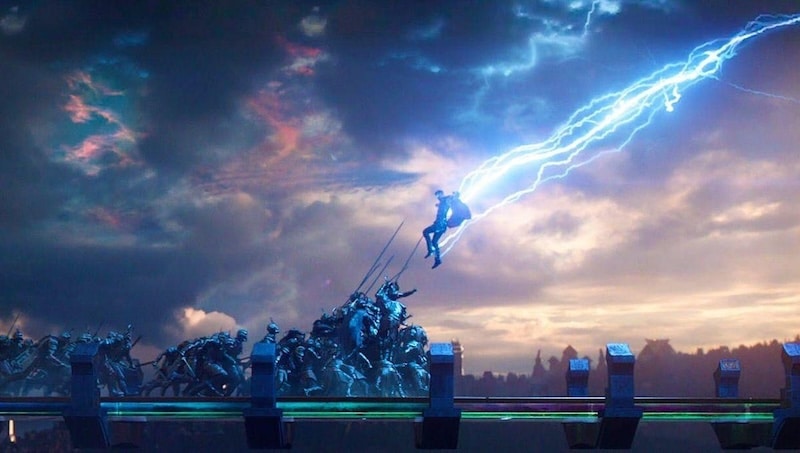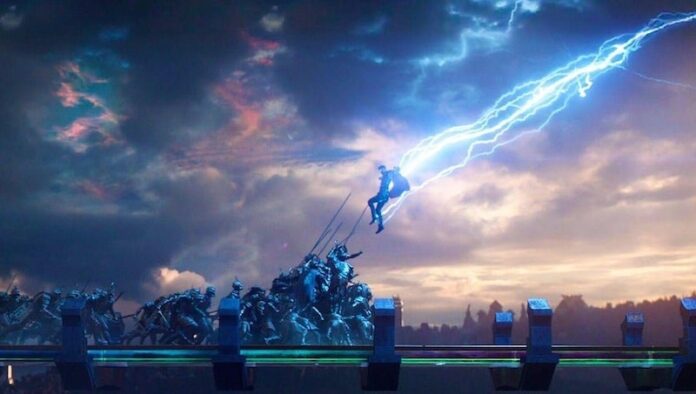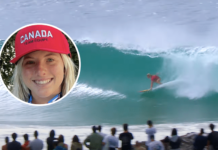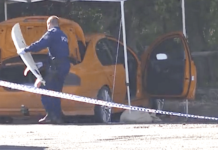
Examine the finless wizard’s wild trajectory from fundamentalist Christianity to sexy-as-all-hell art and surf.
“What does one prefer? An art that struggles to change the social contract, but fails? Or one that seeks to please and amuse, and succeeds?” Robert Hughes, The Shock of the New.
The artist, brown-skinned and barefoot like everyone else in this neighbourhood, wears blue jeans and a matching shirt unbuttoned three deep as he pads through the beachfront apartment that serves as studio and living quarters, three commissions in various stages of completion leaning against the kitchen wall.
Readying for delivery are “Non Cheri”, four feet by five, white stars on a rose background, words in Marlboro’s familiar serif font, three thousand dollars; “As the Sun Sets”, six feet by two-and-a-half feet, palm trees, rodeo cowboy, ‘Au Coucher Du Soleil” in French, seven thousand dollars; “Cowboy Love”, three feet by two-and-a-half feet, torso and head outline of a cowboy, ‘L’amore Cow-Boy’ in French, three gees.
Jacob Leigh Pedrana, artist handle Jakey Pedro has, in a perfect flurry of oil and canvas and red wine-fuelled inspiration, transmogrified from blue-collar plasterer to in-demand artist whose joyously coloured rodeo cowboy-themed works festooned with French idioms are the latest must-have for Australia’s culturally well-heeled set.
Thick worker’s hands that once gripped hammers and banged drywall on the dawn-to-dusk building site grind are now employed delicately wielding brushes and paint sticks.
“It’s hard to explain how quickly it all happened,” says thirty-eight-year-old Jake, who reconnected with the art that consumed him as a kid during 2020’s pandemic. “It’s like I’ve been given this new life. It’s like being reborn.”
People would ask him if the work was for sale and with his trade shuttered for the foreseeable future and down and out in a part of town where even a modest attached home sells for two million dollars, Jake was introduced to the concept of art as bullion.
His first piece, a small abstract on paper sold for four-hundred dollars.
A commission came from Hawaii via DM for a six-foot-by-six-foot “dinosaur moonscape” and Jake, who ain’t short of confidence, quoted the man eight-thousand dollars for the work. Within an hour his PayPal account was inflated to an hitherto unknown high.
And that, as they say, was that.
Jake used the eight gees to buy oil paints and oil sticks and tossed away his cheap chainstore tools, and the commissions haven’t stopped, the pace quickening week by week, myriad exhibitions sought by galleries, restaurants ordering murals.
His surf clothing sponsor, The Critical Slide Society, even released a limited edition trunk, the pink fabric garlanded with his trademark rodeo cowboy.
Jake says his sudden ability to survive just from sales of his paintings, feels like a gift from God, but is quick to clarify he means kismet or providence, and not the the Christian concept of God which was belted out of him after being raised in a Pentecostal household.
“I saw some weird shit at Church when I was a kid,” he says. “Church attracts people who are really hurting and I didn’t know that. I thought Church was really kind. I saw a lot of dark things.”
Dark? Yeah, like the time he and the pastor’s kid were hiding in the Church office and he watched as donations suckered from the flock for a flood in Samoa were divvied up between the Church officials, the men laughing at how much money they’d made.
“I felt sick,” says Jake.
**********
Above the six-feet-and-two-inch artist’s head, which pivots on a light heavyweight’s two-hundred pound frame dramatised by excessively broad shoulders, are two finless wooden alaia-style boards.
Jake shaped ‘em using hand tools and carved from Paulownia tree blanks sent from Noosa by old friend and shaping mentor Tom Wegener.
Readers may remember Tom as the Joker from Phil Jarratt’s 2006 (Alex: can you check it’s issue 14:1) Journal profile of the Palos Verdes-raised former lawyer who threw in the cash-grab to live in blissful harmony shaping ancient surfboards at Noosa Heads.
Jake, a bodyboarder of renown whose drop-knee wizardry had taken him to the Australian Titles, was born in the hills out behind Noosa and on a trip home in 2007 became fascinated with Wegener’s alaias.
This was a decade after bodyboarding’s spectacular nineties peak when Encinitas drop-knee king Paul Roach had turned Machado and his Momentum pals onto trailsides, a time when Tom Morey’s squared-off pieces of foam looked set to overtake trad fibreglass board surfing.
By 2007, however, the magic had faded and bodyboarders had started turning to stand-up surfing and its alternatives.
The trip home coincided with Wegener being filmed for a vignette in the Thomas Campbell film The Present, the smiling Californian with the mild, defenceless eyes of a lamb living the Country Soul dream of shaping wooden boards out the back of his little shack. And it was the shredding of one of Wegener’s team riders, Jacob Struth on these little wooden boards that just…hit…Jake.
In short order, Jake struck up a conversation with Wegener at National Park during a swell, and after riding an alaia at the famous points, told him he wanted to shape and create his own versions.
“I got up straight away, it felt natural and didn’t feel one bit weird. I wanted to be involved in it, heavy involved,” says Jake. “You gotta swim the alaias, they don’t float, you’re literally swimming the whole time. It’s like wakeboarding, you have to get ‘em up on the plane but once you’re going, you’re fucking…on.”
By 201o, the pair were collaborating on a mass-production alaia that was accessible to average surfers.
“The ancient alaias, they’re great to ride but they’re physically demanding – only one in one thousand surfers can actually ride one,” says Wegener, who is now fifty-eight. “We thought, is there a way to take this really elegant, difficult type of surfing and bring it to the masses so other people can get turned onto the glide of ancient surfing? Ancient surfing is finless surfing and the ancients were very, very good at surfing.”
The pair worked to find a shape that kept the essential being of the alaia, the basic tombstone shape with a slight parabolic rail towards the tail, that didn’t require its operator to be superhuman.
“I knew how a bodyboard flexed so we worked well together,” says Jake.
The result was the Albacore, a finless board available as a 4’11” or a 5’6” and made from flexible foam that sold for two hundred dollars a piece via Global Surf Industries, at one point the biggest surfboard manufacturer in the world.
Marketed as “a simple finless board that is complimenting the craze of finless surfing, with a safe, user friendly way of getting a piece of this type of surfing”, the Albacore sold well enough but, says Wegener, “didn’t light the world on fire.”
Wegener says GSI impressed him with their desire to “advance surfing by taking on different projects”. The project, he says, was stymied by distributors who needed surfboards that were a guaranteed sell.
Which meant the wildly eccentric Albacore, even with its surf bonafides demonstrated to devastating effect by Jake at a Javanese slab and at Fiji’s Cloudbreak, wasn’t even visible to the average surfer.
“The Albacore was very easy to surf for a snowboarder and so the few Albacores that went to Europe, the guys loved ‘em,” says Wegener. “They’re no different to a snowboard…it’s still a very relevant idea.”
GSI were so thrilled with Jake’s involvement in the project he became a team rider, the company viewing him as a surf unicorn, that rare shredder who can articulate feeling from a surf craft, whether it’s a bodyboard, a noserider or a lip-swatting five-six.
A dozen years after the fact, Wegener is still elevated when he describes sitting on the beach at Noosa on Christmas Day 2011 watching Jake impose his unique lines.
“He’s the best backside finless surfer I’ve ever seen,” says Wegener. “He was going down the point doing off the lips but 360 off the lips, one after the other…backside… drifting across the lip 360s, engaging the rail, doing another 360. It was so breathtakingly beautiful. Of course, I didn’t have my camera that particular day. You’ve never see anything like it.”
**********
If you want to talk about the influences that shaped Jake and his rodeo cowboys, think of those artists that emerged at various points in the twentieth century to storm the citadels of tradition – the Pop Art of Warhol, Picasso’s Cubism, Wassily Kandinsky and Abstraction, Matisse and Fauvism, Basquiat and Schnabel’s brute primitivism.
Schnabel’s work produced outdoors in Mexico, his velvet canvasses spread out in the dirt, in particular, sung to Jake.
“He’s a surfer as well and I loved that he used to paint huge scale paintings right on the beach. He’d go down to Mex, paint on the beach right there and do the coolest installations.”
More than Schnabel or the obvious parallels to Basquiat’s brightly coloured and frenetic graffiti style, Jake says it’s surfing that inspires.
“Even though I don’t surf much anymore, a few times a week, and as corny as it sounds, surfing is an art form. I’ve taken that feeling of being the artist in the water and putting in on canvas. They both help each other. Surfing helps my art and art helps my surfing. Not just wine.”
The cowboy motif reappears because of Jake’s upbringing a forty-five minute drive from the beach.
“I was a surf cowboy,” he laughs.
Before he paints, Jake will buy a twenty-dollar bottle of Pinot Noir and mix the colours, combing an oil base through a dry pigment to create washed-out pastels and washed-out fluoro colours for what he describes as an early nineties feel.
“Soft pastel pinks and light blues because when you put a big black oil stick over the top of a bright colour it pops.”
Jake wants pop because the feeling the artist wants you to experience is lightness.
When Jake separated from the mother of his son Ryka in 2018 when the kid was one it was an added motivations to aim his light at that fabled north star.
“I wanted to break that pattern of traditionalism that I was born into, the working class ideal where you’re forced to work for the man, the company, whatever. My gift to Ryka is to show him you can love what you do. I didn’t want him to see me miserable as a plasterer.”
Wegener says he finds it difficult to describe the happiness he feels seeing his protege killing it on the art scene.
“The sheet-plasterer guy, doing that, it didn’t suit him. He’s a very, very special person. He’s so much more. He senses more, he has a heightened awareness. Him and his son Ryka, what a team they are. It’s a buzz to see him painting with the kid in between his legs doing his own painting. And that’s the great quality Jake has. It’s a super empathy that he feels with people. And it comes through in his surfing and his art.”





